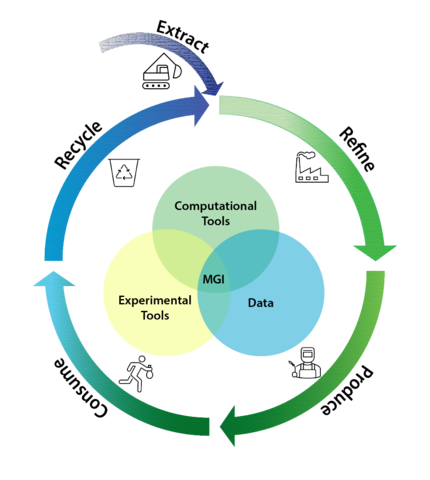Summary
The National Institute of Standards and Technology (NIST) is committed to advancing sustainability in the metals processing industry by developing cutting-edge technologies, standards, and data infrastructure and developing alloys for improved recyclability.
Description

Foundational measurement science is being developed to support sustainable innovations through alloy design and optimization. The integration of experiments and computational thermodynamics and kinetics tools with mechanistic models enables the prediction of key processing-structure-property relations. The goals of this work include:
- Reducing the reliance on critical materials in industry through alloy design
- Mitigating recycling contamination issues by developing impurity-tolerant alloys
- Developing more sustainable metals processing methods including:
- Developing novel AM processing methods to enable the design of location specific properties for custom parts
- Developing novel AM alloys that require less post build processing
- Improving the understanding of the thermodynamics and kinetics associated with iron ore hydrogen reduction processes.
- Developing more energy efficient heat treatments
Circular Steel Pathways
NIST is advancing the foundation for a more efficient and secure domestic metals supply chain. As demand for metals continues to outpace available high-quality scrap, innovations in both primary and secondary processing are needed. NIST is developing measurement science, materials solutions, and process understanding to enable more efficient production pathways, including advancements in direct reduction of iron ores and impurity control. Through technical leadership and stakeholder engagement, this work aims to strengthen domestic capabilities for a resilient metals supply chain
Impurity tolerant alloys
The increasing global demand for structural alloys, such as steel and aluminum, has fostered an increase in the use of scrap to reduce cost and energy consumption. This shift towards more sustainable practice creates an inherent challenge of potential contamination in recycled metals. Impurities are known to promote the formation of deleterious secondary phases during processing that adversely affect ductility, formability, and corrosion resistance. This research will use state-of-the-art materials characterization capabilities to characterize the microstructures produced by higher impurity contents. Material characterization includes SEM and TEM methods, lab and synchrotron X-ray diffraction, DSC, dilatometry, synchrotron X-ray and neutron residual stress measurements at multiple length scales, and synchrotron ultra-small-angle X-ray scattering. Correlations will also be made between microstructure and materials property measurements (hardness, tensile, corrosion resistance, environmental cracking, etc.)
Mutli-material Deposition Processing
Multi-material deposition processing methods are being developed to increase part longevity through novel AM processing by enhancing part functionality with site-specific deposition and as method to reduce the critical materials needed in a given part. The current processing methods are being developed for metallic materials using a custom directed energy deposition system.
Thermodynamic Quantification for Critical Materials Separation and Recovery from Microelectronic Waste Streams
This work, which is funded by the CHIPS Metrology Program, is focused on developing more efficient methods for recovering critical materials, such as In, Ga, and Sb, from microelectronic waste streams. This work will provide critical measurement data for improved recovery processing: activation energies for evaporation, activity coefficients as function of vapor pressure, vaporization kinetics, etc. Measurements will be made for model alloys in the Ga, In, and Sb systems and selected e-waste streams. These measurement will then be used to improve CALPHAD-based databases that can be used to predict vapor-liquid equilibria in multicomponent systems

